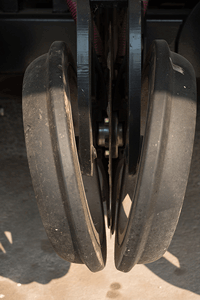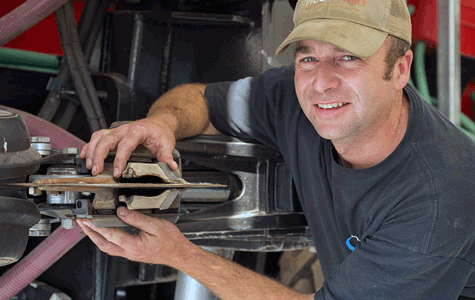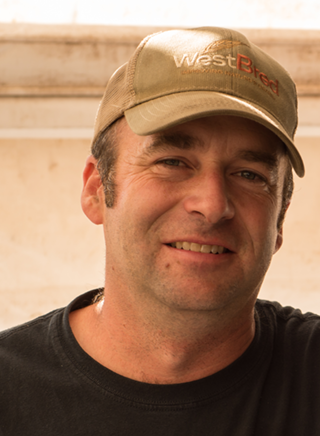 The "My No-Till Journey" blog is where farmers who are newer to no-till practices share how they tackle challenges and push to succeed. Throughout the next year, Kalispell, Mont., grower Doug Manning shares his journey to implementing no-till on his farm, where he raises wheat, barley, peas and canola. Feel free to leave comments, or tips about succeeding with no-till, at the conclusion of each post.
The "My No-Till Journey" blog is where farmers who are newer to no-till practices share how they tackle challenges and push to succeed. Throughout the next year, Kalispell, Mont., grower Doug Manning shares his journey to implementing no-till on his farm, where he raises wheat, barley, peas and canola. Feel free to leave comments, or tips about succeeding with no-till, at the conclusion of each post.
Hello! My name is Doug Manning. Chaela is my wife of 17 years, and we have six children: Sean (14), Carlin (12), Michael (9), Katie (6), Kellan (4) and Daniel (2). Chaela and I met at Gonzaga University, where I earned my BBA in finance.
After graduating, we married and began our life on the farm here in Kalispell, Mont. I have been blessed with the opportunity to return to the Flathead Valley and become the fourth-generation farmer of the original homestead, which was established in 1893.
At that time, I began to develop partnerships with my own landlords and have steadily increased the acreage that my Dad and I farm together.
The ground that we have farmed was entirely conventionally tilled until the spring of 2013. Crops typically raised in our farm are wheat, barley and peas, with canola being added in 2009. A typical rotation for us would be wheat-canola-wheat-barley-peas. We used to include a summer-fallow rotation, but we are moving away from that practice. Instead, we are experimenting with a forage brassica cover crop.
Current research is indicating that keeping the ground covered with a green crop is beneficial for the soil. It protects the microorganisms from the sun’s powerful rays and sometimes baking temperatures. The root development provides organic matter, creates routes for precipitation penetration and frees compaction. In addition, summer fallow weed management was a costly practice in terms of fuel, labor and tractor wear.
Our climate is influenced by our location in the northwest corner of Montana, in a mountain valley. We have an average rainfall of 15 inches per year, and have a relatively short growing season.

|
|
GETTING STARTED. Doug Manning no-tills wheat, barley, peas and canola near Kalispell, Mont., and adopted no-till practices in 2013. |
Planting begins in mid-April and harvest begins in August. The mountain valley was formed by glaciers, which left deposits of rich soil. The Flathead River flows through the valley and it has left soil deposits over the years as well.
Soil types vary and include sand, clay, sandy loam, and Creston loam. Typically, the soil is higher yielding dryland — however, some acres are irrigated. This unique region has numerous challenges. The mountains create geographic isolation. The close proximity to multiple recreation venues — such as ski resorts, lakes, rivers, national forest and Glacier National Park, and the natural beauty of the area — have encouraged development, and elevated property values.
These and other factors have led to small field sizes, multiple landlords and suburban interface challenges. One farm co-op and one machinery dealership serve the area. Shipping grain, and access to supplies and parts, can be challenging at times.
Local farm practices have primarily regarded tillage as the only way to manage high levels of residue. Tillage has been the known-and-understood practice for 80% of farmable acres for managing weeds, and for preparing the seedbed. It is also a great reason for getting to drive the tractor!
As I gained more farm experience, I began to seek ways to improve the yield potential of my crops. I started to look more closely at factors that were limiting that potential.
One factor that I identified was fertilizer placement. I began to study systems that could place nutrients at the right time and place, and in the correct amount, for that particular crop or field.
My business education had ingrained in me the desire to increase efficiency and, thereby, increase profitability, so I sought practices that could meet efficiency goals. A single-pass farming system provided a solution to being more efficient when covering numerous small-acreage farms.
The systems that I studied led me to see the benefits of reduced tillage, initially, and then no-till. As I considered a change, I began to learn the benefits of moisture conservation and improved soil health through no-till. These factors led to the decision to implement monumental changes in our farming philosophy and practices.
Our goal has become to improve soil health and run a more efficient farm operation. The changes we’ve implemented in order to achieve those goals include purchase and use of a truly no-till Cross Slot drill, and planting cover crops. We have reduced fall work and eliminated the plow. We are monitoring field nutrient needs and responding appropriately. We will continue to study and research new practices that benefit the soil and the business.

|

|
|
NEW MACHINE. Doug Manning elected to start his journey by purchasing a Cross Slot no-till drill, which he believes will help him meet the goal of improving operational efficiencies and soil health on his farm. |
|
The debate continues within the family and throughout the community about the efficacy of the implemented changes. Generational differences regarding the appearance of crops, the management of residue, taking the “sport” out of farming by reducing the number of hours in the seat of a tractor, and doubt about whether anything new can work — as well as the old — have led to many conversations. Some conversations have been productive and thoughtful. Some neighbors are intrigued by the potential of the new practices. Landlords with the intention of leaving a legacy of healthier farms behind are quite supportive.
Even though members of the community recognize the need for greater efficiencies and improved soil health, many are unwilling to take the risks to adopt the new practices. Until multiple years of obvious positive results (i.e. higher yields, drought resistance, lower input costs) are apparent, many will be unwilling to change.
But on my farm, the journey to implementing no-till practices continues, and I look forward to sharing my story with you.







Post a comment
Report Abusive Comment